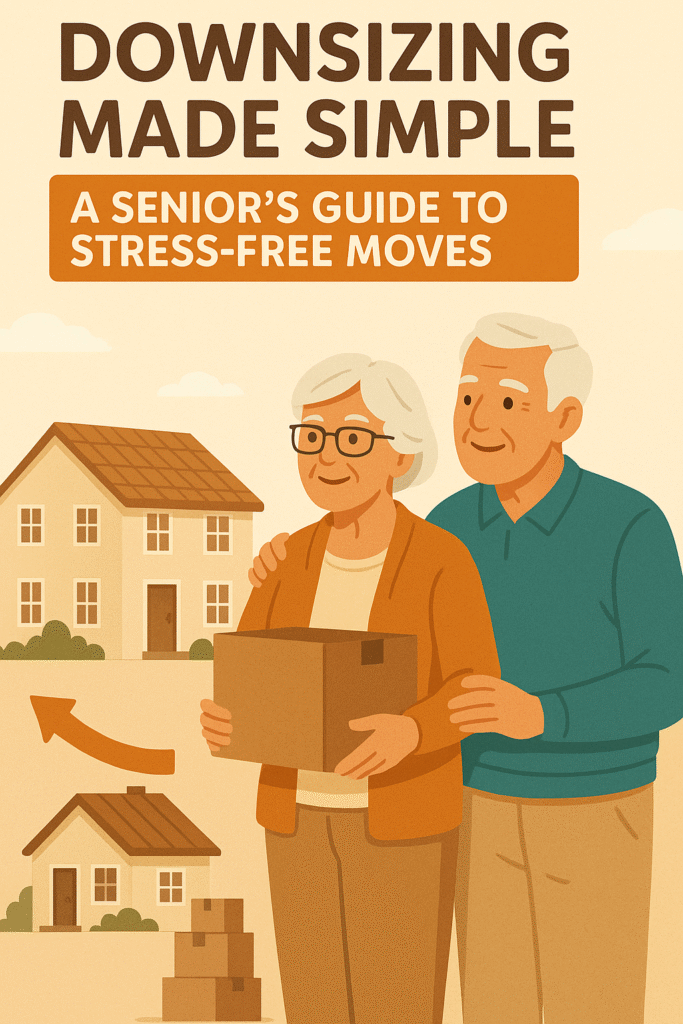
Why Downsizing is a Growing Choice for Seniors
Across the country, more and more seniors are choosing to downsize—trading in large family homes for something smaller, easier to manage, and better suited for their current stage of life. Whether the move is motivated by financial goals, health considerations, or simply a desire for simplicity, downsizing offers seniors a chance to reduce stress, free up time, and embrace a new chapter. But the process isn’t always easy. With the right strategies and support, however, downsizing for seniors can truly become a stress-free moving experience.
Why Seniors Choose to Downsize
Downsizing is rarely just about the size of a home—it’s about the lifestyle it supports. Seniors often find themselves motivated by a combination of emotional, financial, and practical reasons.
- Emotional Freedom: A smaller home means less upkeep and more energy for hobbies, family, and relaxation. Seniors often discover they no longer need extra rooms filled with furniture that goes unused.
- Financial Relief: Selling a larger home can free up equity to fund retirement, healthcare, or travel. Lower utility bills and maintenance costs also make life more affordable and predictable.
- Lifestyle Shifts: With children grown and careers retired, seniors may want to live closer to family, healthcare, or amenities. Downsizing allows for a home that matches current needs instead of past obligations.
Common Challenges in Downsizing
While the decision to move is liberating, the actual process of downsizing can feel overwhelming.
- Sorting Belongings: Seniors often have decades of possessions, many with sentimental value. Deciding what to keep, donate, or sell can feel like reliving a lifetime of memories.
- Emotional Attachments: Letting go of family heirlooms or parting with a home full of history isn’t easy. Emotions can stall progress or make decision-making difficult.
- Moving Logistics: Coordinating movers, packing, and managing the timeline can be stressful, especially for seniors managing health limitations or fixed schedules.
Acknowledging these challenges upfront is the first step toward overcoming them.
Step-by-Step Guide to Stress-Free Downsizing
1. Start Decluttering Early
Begin with one room at a time and separate items into categories: keep, donate, sell, or discard. Tackling small spaces first builds momentum and prevents burnout.
2. Create a “Must-Keep” List
Identify essential furniture, clothing, and keepsakes before sorting the rest. This ensures that the most meaningful and practical items are prioritized.
3. Donation & Selling Tips
Items no longer needed can bring joy to others. Consider donating to local charities, faith organizations, or family members. For valuables, online marketplaces and estate sales can help offset moving costs.
4. Hire Professional Help
Senior move managers and downsizing specialists understand the physical and emotional challenges of relocation. They provide packing, organizing, and even resale services, making the process much smoother.
By breaking the process into clear steps, downsizing shifts from overwhelming to manageable.
How Family & Professionals Can Support Seniors
Support systems are crucial to stress-free downsizing.
- Family Support: Loved ones can help sort belongings, share memories, and provide encouragement during tough decisions. Having someone present makes the process less lonely.
- Real Estate Specialists: Working with a senior-focused real estate professional ensures the home sale and purchase are tailored to the client’s needs. These agents understand timing, accessibility, and financial goals.
- Professional Movers: Movers with experience in senior relocation can handle packing, heavy lifting, and careful transport of belongings.
- Counselors or Coaches: For those struggling emotionally, professional counseling provides coping strategies to handle the transitions with peace of mind.
The right team makes downsizing less about “losing” and more about “gaining.”
The Emotional Side of Downsizing
Moving isn’t just a logistical task—it’s an emotional journey. Many seniors fear that downsizing means leaving memories behind. But it’s important to remember that memories live in people, not objects.
Here are a few ways to preserve cherished moments while embracing change:
- Create a Memory Book: Photograph rooms, keepsakes, or family gatherings before moving. This helps preserve the feeling of the home without needing to keep everything.
- Pass Along Heirlooms: Giving meaningful items to children or grandchildren turns downsizing into a way of strengthening family bonds.
- Focus on the Future: Downsizing opens doors to new friendships, opportunities, and lifestyles. Reframing the move as a beginning, not an ending, helps seniors embrace the next chapter with optimism.
Conclusion: Downsizing as a Fresh Start
Downsizing for seniors isn’t about giving up—it’s about gaining freedom, clarity, and peace of mind. With the right plan and support, stress-free moving is absolutely possible. At Glen Guadalupe Real Estate, we specialize in guiding seniors through every step of the downsizing process, ensuring the transition feels like a fresh beginning.
Ready to make your next chapter simple and stress-free? Work with Glen Guadalupe for expert senior relocation guidance.
FAQ
How do I start downsizing?
Start small by focusing on one room or category at a time. Create a timeline, make a “must-keep” list, and set aside items to donate or sell.
What if I feel overwhelmed by letting go?
It’s natural to feel emotional. Break tasks into smaller steps, involve family or a professional, and focus on the future benefits rather than the loss.
How long does the process usually take?
Every situation is unique, but most seniors take several weeks to a few months to fully downsize, depending on the size of their home and level of support.

